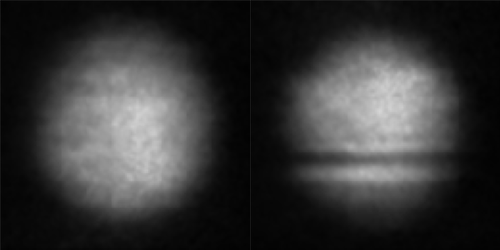Solitons of All Speeds
Shape-maintaining solitary waves are ubiquitous in physics, appearing in large astrophysical systems, such as the Sun’s plasma, and tiny quantum ones, such as Bose-Einstein condensates (BECs). Researchers have long known how to make a soliton in a BEC, but they hadn’t been able to control the wave’s velocity. Now Amilson Fritsch and colleagues, jointly at the National Institute of Standards and Technology, Gaithersburg, and the University of Maryland, demonstrate a way to do exactly that. Using the technique, the team generate near-stationary solitons—a previously unachieved feat—as well as some that travel at up to half the speed of sound.
Solitons in BECs made of repulsively interacting atoms are traditionally “dark,” manifesting as wave-like, reduced-density patterns of atoms. To make these solitons, researchers illuminate half of the BEC with laser light, imprinting a phase difference on the BEC’s wave function. This resulting phase step propagates when the laser is removed. In theory, researchers can create solitons with any velocity by tuning the phase difference, but that requires imprinting an abrupt phase jump. In practice, they normally end up with a smooth, few-micrometer-wide transition, which limits the possible wave velocities.
Fritsch and colleagues solve this problem by tuning the BEC’s density as well as its phase. First, they illuminate the BEC with a narrow laser stripe that reduces the atom density along its width, and then they imprint the phase difference. This two-step process allows them to more accurately generate the wave function of the desired soliton, allowing greater control over its velocity. The team says that before this demonstration, researchers creating solitons were like pitchers who only threw fastballs. Now soliton “pitchers” can throw any ball they want.
This research is published in Physical Review A.
–Katherine Wright
Katherine Wright is a Senior Editor for Physics.




